Aquarium

Pink skunk clownfish, Amphiprion perideraion
The Pink skunk clownfish is named for its pink coloration and the narrow white head band and white dorsal stripe. It is a coral reef dweller often associated with the Magnificent sea anemone, Heteractis magnifica. It is found in the tropical Western Pacific from the Philippines to Japan and Micronesia to Australia and Samoa. It is a hardy species that breeds readily in an aquarium environment.
LEARN MORE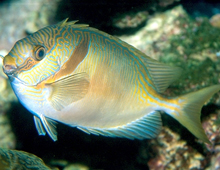
Barred spinefoot, Siganus doliatus
The Barred spinefoot, or Rabbitfish, is named for its striped coloration and its rabbit-like grazing behavior. Like other members of its family, the Barred spinefoot is herbivorous and its mouth is designed especially for removing algae from the rocks or coral branches. The upper jaw is fixed and only the tip of the mouth can move, creating a nibbling action. The Barred spinefoot is found in very shallow water in the Western Pacific, living most of its life at depths of less than ten feet.
LEARN MORE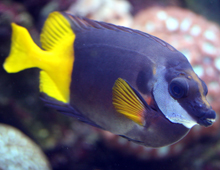
Spinefoot foxface, Siganus uspi
The Spinefoot foxface, or Bicolor foxface is a member of the Rabbitfish family, Siganidae. It is found in the Western Pacific and is endemic to the Fiji Islands. Like other foxfaces, the Spinefoot foxface has venomous dorsal spines. By nature, foxfaces are herbivores and can be seen grazing on algae growing amongst their coral reef habitat.
LEARN MORE
Tomato clownfish, Amphiprion frenatus
The Tomato clownfish is named for its bright red coloration, which can vary in shade from burnt orange to tomato red. They are one of the larger clownfish species, and can be one of the most aggressive. Females are generally larger than the males, and clownfish have the ability to change sex from male to female. In the Fiji exhibit, Tomato clowns frequently lay eggs, usually on the underside of a rock, and just underneath the safety of a large anemone.
LEARN MORE
Lyretail anthias, Pseudanthias squamipinnis
The Lyretail anthias, also known as the Scalefin anthias, is found in the Indo-West Pacific, often in large aggregations. The brightly colored pink males and orange females can be seen feeding on zooplankton throughout the day. Like other members of the Serranidae family, the Lyretail anthias is hermaphroditic. Males choose a harem of females with which to mate. In the absence of a male, the dominant female will become a male. In this case, the female’s orange coloration will change to pink and her dorsal fin will become more ornate.
LEARN MORE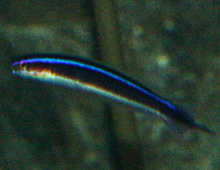
Bluelined hulafish, Trachinops brauni
The Bluelined hulafish, or Braun’s hulafish, is a little known species found in the subtropical waters of Australia. It is a small fish reaching a length of three inches with a bright blue stripe running horizontally from head to tail. It is a schooling fish and can be found in large numbers feeding on zooplankton. A nesting species, males of this species are believed to protect the eggs until hatching.
LEARN MORE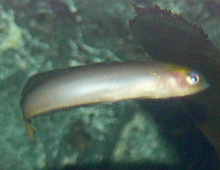
Yellowhead hulafish, Trachinops noarlungae
The Yellowhead hulafish, or Yellow-headed pretty fin as it is also known, is a small schooling fish often found under jetties or on rocky reefs. It is endemic to the temperate waters of Southern and Western Australia. This relatively small species reaches a length of only four inches and can be found in large schools. The Yellowhead hulafish is named for the yellow coloring on its head and its dancing like movements in the water.
LEARN MORE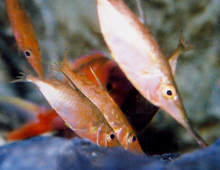
Longspine snipefish, Macrorhamphosus scolopax
The Longspine snipefish, a Syngnathiform fish is a distant relative of the seahorses, pipefish and seadragons. It is also known as a Bellows fish for the way its fused jaws draw in water through its long, slender snout. It is found around the world in subtropical or temperate seas. It feeds on small zooplankton and worms, and usually swims vertically, head down. It is reddish pink in color and it is reported to grow to more than seven inches in length.
LEARN MORE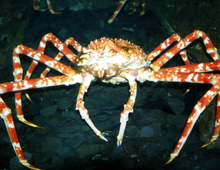
Japanese spider crab, Macrochaeira kaempferi
The Japanese spider crab is the largest living arthropod, reaching 13 feet in arm span. It is an omnivorous scavenger feeding on decaying animal and plant matter. Found in the cold, deep waters off the coast of Japan, the Japanese spider crab is known to breed between the months of January and April each year. Females of this species can carry up to 1.5 million eggs each season. The exact life span of these giant crustaceans is unknown, but it is believed that they can live more than 50 years, with some reports suggesting that they can survive for more than 100 years.
LEARN MORE
Threadfin snapper, Symphorichthys spilurus
Like many wrasses, this relative of the popular red snapper undergoes remarkable changes in colors and fin shape as it reaches adulthood, but it remains quite striking throughout this process. While the long-finned youngsters have a simple but attractive geometric pattern, the short-fined adults, which can reach two feet, are festooned in electric blue stripes that have earned them the name of Chinese gown fish in Australia. This fish has a wide distribution in the Indo-Pacific.
LEARN MORE

